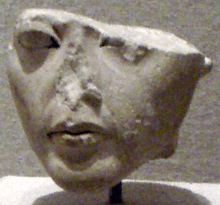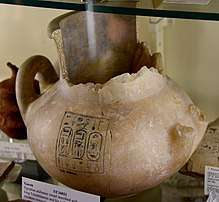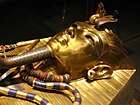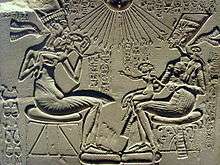Ankhesenamun
Ankhesenamun (Ancient Egyptian: ˁnḫ-s-n-imn, "Her Life Is of Amun"; c. 1348 – after 1322 BC) was a queen of the Eighteenth Dynasty of Egypt. Born Ankhesenpaaten (Ancient Egyptian: ˁnḫ.s-n-pꜣ-itn "she lives for the Aten")[1] she was the third of six known daughters of the Egyptian Pharaoh Akhenaten and his Great Royal Wife Nefertiti, and became the Great Royal Wife of her half-brother Tutankhamun.[2] The change in her name reflects the changes in ancient Egyptian religion during her lifetime after her father's death. Her youth is well documented in the ancient reliefs and paintings of the reign of her parents. Tutankhamun and Ankhesenamun shared the same father but Tutankhamun's mother has recently been identified through DNA analysis as one of Akhenaten's sisters, a daughter (so far unidentified but informally known to scientists as The Younger Lady) of Amenhotep III.[3]
| Ankhesenamun | |
|---|---|
| Queen consort of Egypt Great Royal Wife | |
 Broken statuette of an 18th dynasty woman believed to be Ankhesenamun. Brooklyn, United States | |
| Tenure | ca. 1332–1323 BC |
| Born | ca. 1348 BC Thebes |
| Died | ca. 1322 BC (aged ca. 26) |
| Burial | Maybe KV21 |
| Spouse | Tutankhamun (half-brother/cousin) Ay (grandfather/great-uncle) |
| Issue | Possibly two stillborn daughters, 317a and 317b |
| Dynasty | 18th of Egypt |
| Father | Akhenaten |
| Mother | Nefertiti |
| Religion | Ancient Egyptian religion |
Ankhesenamun was definitely married to one king: she was the Great Royal Wife of Pharaoh Tutankhamun. It is also possible that she was briefly married to Tutankhamun's successor, Ay, believed by some to be her maternal grandfather.[4]
Recent DNA tests released in February 2010 have also speculated that one of two late Eighteenth Dynasty queens buried in KV21 could be her mummy. Both mummies are thought, because of DNA, to be members of the ruling house.[3]
Early life
| Ankhesenamun in hieroglyphs | ||||||||
|---|---|---|---|---|---|---|---|---|
Ankhesenpaaten (anḫ s n pa itn) Translation, Living for Aten | ||||||||
Ankhesenamun (anḫ s n imn) Translation, Living for Amun | ||||||||
Ankhesenpaaten was born in a time when Egypt was in the midst of an unprecedented religious revolution (c. 1348 BC). Her father had abandoned the old deities of Egypt in favor of the Aten, hitherto a minor aspect of the sun-god, characterised as the sun's disc.
She is believed to have been born in Waset (present-day Thebes), around year 4 of her father's reign, but probably grew up in the new capital city of Akhetaten (present-day Amarna). The three eldest daughters – Meritaten, Meketaten, and Ankhesenpaaten – became the "Senior Princesses" and participated in many functions of the government and religion.
Later life

She is believed to have been married first to her own father.[5] This was not unusual for Egyptian royal families. She is thought to have been the mother of the princess Ankhesenpaaten Tasherit (possibly by her father or by Smenkhkare), although the parentage is unclear.[2]
After her father's death and the short reigns of Smenkhkare and Neferneferuaten, she became the wife of Tutankhamun. Following their marriage, the couple honored the deities of the restored religion by changing their names to Tutankhamun and Ankhesenamun.[6] The couple appear to have had two stillborn daughters.[3] As Tutankhamun's only known wife was Ankhesenamun, it is highly likely the fetuses found in Tutankhamun's tomb are her daughters. Some time in the ninth year of his reign, at about the age of 18, Tutankhamun died suddenly, leaving Ankhesenamun alone without an heir at about age 21.[6]
A blue glass ring of unknown provenance obtained in 1931 depicts the prenomen of Ay and the name of Ankhesenamun enclosed in cartouches.[7] This indicates that Ankhesenamun married Ay shortly before she disappeared from history, although no monuments show her as a royal consort.[8] On the walls of Ay's tomb it is Tey (Ay's senior wife), not Ankhesenamun, who appears as queen. She probably died during or shortly after his reign and no burial has been found for her yet.
Hittite letters
A document was found in the ancient Hittite capital of Hattusa which dates to the Amarna period: the so-called "Deeds" of Suppiluliuma I. The Hittite ruler receives a letter from the Egyptian queen, while being in siege on Karkemish. The letter reads:
My husband has died and I have no son. They say about you that you have many sons. You might give me one of your sons to become my husband. I would not wish to take one of my subjects as a husband... I am afraid.[9]
This document is considered extraordinary, as Egyptians traditionally considered foreigners to be inferior. Suppiluliuma I was surprised and exclaimed to his courtiers:
Nothing like this has happened to me in my entire life![10]
Understandably, he was wary, and had an envoy investigate, but by so doing, he missed his chance to bring Egypt into his empire. He eventually did send one of his sons, Zannanza, but the prince died, perhaps murdered, en route.[11]
The identity of the queen who wrote the letter is uncertain. She is called Dakhamunzu in the Hittite annals, a transliteration of the Egyptian title Tahemetnesu (The King's Wife).[12] Possible candidates are Nefertiti, Meritaten,[4] and Ankhesenamun. Ankhesenamun once seemed likely since there were no candidates for the throne on the death of her husband Tutankhamun, whereas Akhenaten had at least two legitimate successors. but this was based on a 27-year reign for the last 18th pharaoh Horemheb who is now accepted to have had a shorter reign of only 14 years. This makes the deceased Egyptian king appear to be Akhenaten instead rather than Tutankhamun. The phrase regarding marriage to 'one of my subjects' (translated by some as 'servants') is possibly a reference to the Grand Vizier Ay or a secondary member of the Egyptian royal family line. Since Nefertiti was depicted as powerful as her husband in official monuments smiting Egypt's enemies, she might be the Dakhamunzu in the Amarna correspondence as Nicholas Reeves believes.[13] Ankhesenamun may have been pressured by Ay to marry him and legitimize his claim to the throne of Egypt (which she eventually did).[14]
Mummy KV21A
DNA testing announced in February 2010 has speculated that her mummy is one of two Eighteenth Dynasty queens recovered from KV21 in the Valley of the Kings.[15]
The two fetuses found buried with Tutankhamun have been proven to be his children, and the current theory is that Ankhesenamun, his only known wife, is their mother. However, not enough data was obtained to make more than a tentative identification. Nevertheless, the KV21a mummy has DNA consistent with the Eighteenth Dynasty royal line.[15]
KV63
After excavating the tomb KV63, it is speculated that it was designed for Ankhesenamun due to its proximity to the tomb of Tutankhamun's KV62. Also found in the tomb were coffins (one with an imprint of a woman on it), women's clothing, jewelry and natron. Fragments of pottery bearing the partial name Paaten were also in the tomb. The only royal person known to bear this name was Ankhesenamun, whose name was originally Ankhesenpaaten. However, there were no mummies found in KV63.
In popular culture
Ankhesenpaaten/Ankhesenamum appears as a fictionalized character in these works:
- in the Belgian series, Het Huis Anubis, as The Vengeful Wife of Tutankhamun
- as the main character in Christian Jacq's novel La reine soleil, and in the animated film adaptation of the same name
- as a main character in The Twelfth Transforming by Pauline Gedge
- in the manga series Red River by Chie Shinohara, in relation to the Hittite Letters event
- a character in Nefertiti by Michelle Moran, as the third of her six daughters
- as the central character in Lucille Morrison's The Lost Queen of Egypt, from early childhood to her vanishing from history, showing that she ultimately engineered her own disappearance to protect herself. Allen Drury has a similar explanation for Ankhesenamon in his book Return to Thebes, the sequel to A God Against the Gods.
- the main character in the novel Tutankhamun and the Daughter of Ra by Moyra Caldecott
- Her name is used as the love of Imhotep, the titular mummy in the original 1932 film The Mummy, which was made after the publicity surrounding the discovery of Tutankhamun's tomb. She is portrayed by Zita Johann. In the 1999 remake The Mummy and its sequel The Mummy Returns, she is played by Patricia Velásquez. In the 1932 film, her name is spelled Ankh-es-en-amon. In the 1999 film, it is spelled Anck-su-namun.
- The novel Pillar of Fire by Judith Tarr deals in large part with the life of Ankhesenamun.
- in P.C. Doherty's Akhenaten trilogy where she is implicated in Tutankhamun's death and is to marry a Hittite prince
- as a major character in The Murder of King Tut, a murder mystery based on speculation about her husband's death by James Patterson and Martin Dugard
- as a major character in Tutankhamun: the Book of Shadows, and Egypt: the Book of Chaos, by Nick Drake
- in Tut on Spike she is played by Sibylla Deen
Ancestry and family
References
- Ranke, Hermann (1935). Die Ägyptischen Personennamen, Bd. 1: Verzeichnis der Namen (PDF). Glückstadt: J.J. Augustin. p. 67. Retrieved 25 July 2020.
- Dodson, Aidan; Dyan Hilton (2004). The Complete Royal Families of Ancient Egypt. Thames & Hudson. p. 148.
- Hawass, Zahi; et al. (2010). "Ancestry and Pathology in King Tutankhamun's Family". The Journal of the American Medical Association. 303. doi:10.1001/jama.2010.121. PMID 20159872.CS1 maint: ref=harv (link)
- Grajetzki, Wolfram (2000). Ancient Egyptian Queens; a hieroglyphic dictionary. London: Golden House. p. 64.
- Reeves, Nicholas (2001). Akhenaten: Egypt's False Prophet. Thames and Hudson.
- "Queen Ankhesenamun". Saint Louis University. Retrieved 2020-01-14.
- Newberry, Percy E. (May 1932). "King Ay, the Successor of Tut'ankhamun". The Journal of Egyptian Archaeology. 18 (1/2): 50–51. doi:10.2307/3854904.
- Dodson, Aidan; Dyan Hilton (2004). The Complete Royal Families of Ancient Egypt. Thames & Hudson. p. 153.
- Güterbock, Hans Gustav (June 1956). "The Deeds of Suppiluliuma as Told by His Son, Mursili II (Continued)". Journal of Cuneiform Studies. 10 (3): 75–98. doi:10.2307/1359312. JSTOR 1359312.
- "The Deeds of Suppiluliuma as Told by His Son, Mursili II". Journal of Cuneiform Studies. 10 (2). 1956. JSTOR 1359041.
- Amelie Kuhrt (1997). The Ancient Middle East c. 3000 – 330 BC. 1. London: Routledge. p. 254.
- Federn, Walter (January 1960). "Daḫamunzu (KBo V 6 iii 8)". Journal of Cuneiform Studies. 14 (1): 33. doi:10.2307/1359072.
- Nicholas Reeves,Tutankhamun's Mask Reconsidered BES 19 (2014), pp.523
- Christine El Mahdy (2001), "Tutankhamun" (St Griffin's Press)
- Hawass, Zahi; Gad, Yehia Z.; Somaia, Ismail; Khairat, Rabab; Fathalla, Dina; Hasan, Naglaa; Ahmed, Amal; Elleithy, Hisham; Ball, Markus; Gaballah, Fawzi; Wasef, Sally; Fateen, Mohamed; Amer, Hany; Gostner, Paul; Selim, Ashraf; Zink, Albert; Pusch, Carsten M. (February 17, 2010). "Ancestry and Pathology in King Tutankhamun's Family". Journal of the American Medical Association. Chicago, Illinois: American Medical Association. 303 (7): 638–647. doi:10.1001/jama.2010.121. ISSN 1538-3598. PMID 20159872. Retrieved May 24, 2020.
Further reading
- Akhenaten, King of Egypt by Cyril Aldred (1988), Thames & Hudson

